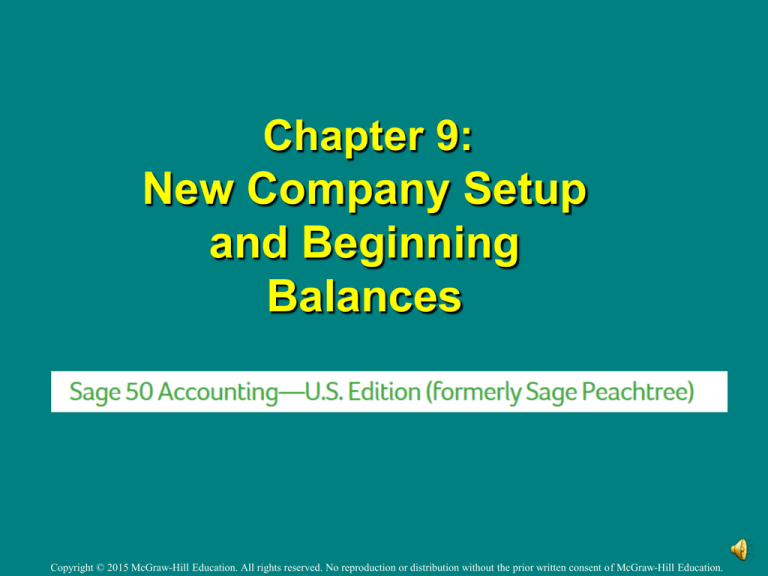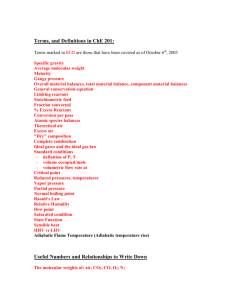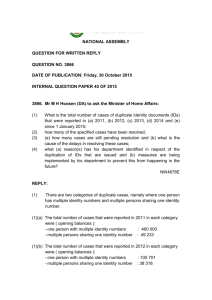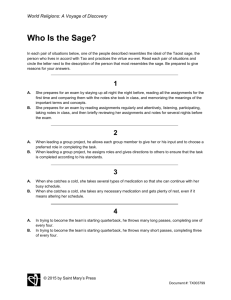
Chapter 9:
New Company Setup
and Beginning
Balances
Copyright © 2015 McGraw-Hill Education. All rights reserved. No reproduction or distribution without the prior written consent of McGraw-Hill Education.
New Company Setup and
Beginning Balances
Chapter 9 begins Part 2 of the book—Sage 50 Complete
Accounting 2015 for Service Businesses. In this part of the book,
you are the owner of an accounting practice that does the monthly
record keeping for several service businesses.
In Chapter 9, you set up two service businesses—Dennis Westin
Designer and the end-of chapter exercise, Art by Your Name. You
set up a business using one of Sage 50’s sample companies.
Then, you record October 1, 2015 beginning balances from Mr.
Westin’s balance sheet.
The chapters in Part 2 work together--the service businesses set
up in Chapter 9 are continued in Chapters 10 and 11.
9-2
Sage 50 Tips
In Chapter 9, beginning balances are entered from the October 1,
2015 balance sheet. This means that the chart of accounts beginning
balances must be entered as of September 30. The September 30
ending balances are the October 1 beginning balances.
The businesses that you set up in Chapter 9 are continued in
Chapters 10 and 11.
Remember to use a unique name for the businesses that you set up
in Chapter 9. For example, use your first and last name Designer to
identify the chapter company and Art by (your first and last name) to
identify the business set up in Exercise 9-1.
When a company is set up in Sage 50, a shortened named is
assigned to the company; for example, the shortened company name
for Dennis Westin Designer is denwesde. When the student’s first
and last name is used, the shortened company name differs.
Use Windows Explorer to see the file size.
9-3
Sage 50 Tips (concluded)
You can restore an existing company—one that is previously set up—
or use the Restore Wizard to Create a new company using the
restored data, bypassing the process of creating a new company. The
Restore Wizard includes two options on the Select Company window:
Overwrite existing company data and Create a new company using
the restored data. If Create a new company using the restored data is
selected, then the company will be named the same as the backup
file.
Let’s say you want to restore a backup file for a company that is not
set up in Sage 50; for example, a back up file exists but the company
is not shown as a Sage 50 company.
If you start Sage 50 and the appropriate company cannot be opened,
use the Restore Wizard to Create a new company using the restored
data. Using the backup file, and the Create a new company using the
restored data, you can set up a company and start at that point in the
data.
9-4
Backing Up Chapter 9
In the textbook, detailed steps are shown for backing up to a USB drive.
Sage 50 Backup (.ptb)
Excel (.xlsx) and Adobe (.pdf)
Kilobytes
Page Nos.
Chapter 9 Chart of Accounts.ptb
948 KB
274-275
Chapter 9 Beginning Balances.ptb
952 KB
289-290
17 KB
290-292
5 KB
295
98 KB
295
Exercise 9-1.ptb
908 KB
299
Exercise 9-2.ptb
912 KB
302
17 KB
302
Chapter 9-2_Chart of Accounts.pdf
8 KB
302
Exercise 9-2_Balance Sheet.pdf
5 KB
302
Chapter 9_Chart of Accounts Beginning Balances.xlsx
Chapter 9_Balance Sheet.pdf
Chapter 9_Chart of Accounts.pdf
Exercise 9-2_Chart of Accounts and Beginning
Balances.xlsx
9-5
Business Status Navigation Center
Period 10 - 10/01/1510/31/15
Navigation Bar
9-6
Shortened name for Dennis Westin
Designer
A folder is set up on the hard drive
for Dennis Westin Designer—
C:\Sage\Peachtree\Company\
denwesde.
Sage 50’s shortened name is the
first three letters from the first word
(den), the second word’s first three
letters (wes), the third word’s first
two letters (de).
If you used your first and last name,
the shortened name will differ.
9-7
Entering Chart of Accounts
Beginning Balances
Select the beginning balance period.
Make sure that From
9/1/15 through
9/30/15 is selected.
Make sure you have selected From 9/1/15 through 9/30/15. You
cannot change the period later.
9-8
Chart of Accounts Beginning
Balances window
Make sure that your beginning balances are as of September
30, 2015. If you enter your balances for the wrong month
(period), your financial statements will not show the current
month and year-to-date amounts correctly in Chapter 11.
9-9
Display the September 30, 2015
Balance Sheet
Change the date on the <Standard> Balance Sheet.
September 30 ending balances are October 1, 2015 beginning balances.
Display the balance sheet for September 30 so you can check that you entered
chart of accounts beginning balances correctly.
9-10
Glossary of Terms
Chapter 9
9-11
Posting, Part 2 introduction
One of the best features of a computerized accounting
system is how quickly posting is done. Once entries are
recorded and checked for accuracy, posting is a click of the
mouse. All entries are posted to accounts in the general
ledger and account balances are calculated—fast, easy,
and accurate. This diagram illustrates the process.
Journalize and
Post
General Ledger
Financial
Statements
9-12
Sage 50 Accounting System
Software
Installation
Reports
Business
Processes
Company
Setup
Journal entries,
Posting to the
General Ledger,
Subsidiary Ledgers
9-13
Double-Entry Accounting
Sage 50 is a double-entry accounting system which
means that the equation Assets = Liabilities + Equity
is always in balance. Since a debit in one account will
be offset by a credit in another account, the sum of all
debits is equal to the sum of all credits.
To guarantee double-entry accounting, Sage 50
includes accounting periods, the general journal and
special journals, general ledger and subsidiary
ledgers, account reconciliation, an audit trail, and
financial reports. Sage 50 also includes closing the
fiscal year.
9-14
Balance Sheet
A Balance Sheet lists the types and amounts of
assets, liabilities, and equity as of a specific
date. The balance sheet is also called a
statement of financial position.
9-15
Statement of Financial
Position
The statement of financial position is also
known as a balance sheet.
9-16
Online Learning Center
Go online to www.mhhe.com/yacht2015 for additional resources.
Link to Student Edition, select Chapter 9.
o
o
o
o
o
o
o
o
Interactive Testing: Online multiple-choice and true and false
questions. Tests are graded and can be emailed to instructor.
Glossary of Terms: Boldfaced/italicized words within chapter.
Feature Quizzes: Includes user interface questions, matching,
and review of chapter concepts with immediate feedback.
Videos: Demonstration of setting up a new company. YouTube
videos are also included.
PowerPoints: Narrated slides.
Assessment Rubrics: Reviews journal entries, reports,
navigation centers, modules, and task windows.
Going to the Net: Internet research.
QA Templates: 10 multiple-choice questions and the analysis
questions.
9-17
Going to the Net
Access information about the chart of accounts at
http://en.wikipedia.org/wiki/Chart_of_accounts.
Read the information on Wikipedia’s chart of
accounts website.
1. What is the chart of accounts?
2. List four asset accounts, two liability accounts,
two equity accounts, one revenue account, and
three expense accounts.
3. What is the trial balance?
9-18
Analysis Questions
What chart of accounts beginning balance
date is used for entering October 1, 2015
account balances in Sage 50?
2. How does the account beginning balance
date affect the current month and year-todate amounts on the financial statements?
1.
9-19
Assessment Rubric
Task
Date
Selections
Window
Shortened
Company
Name
October 1,
2015
Beginning
Balances
9-20





